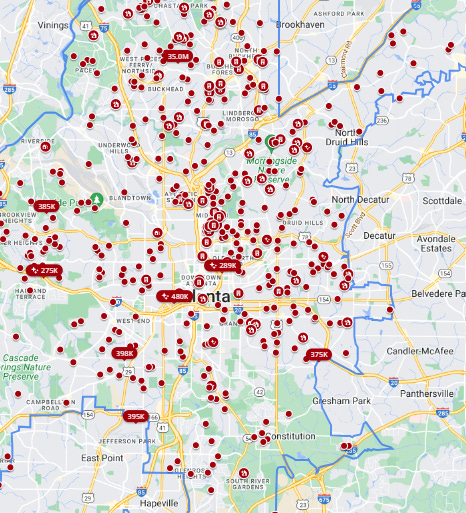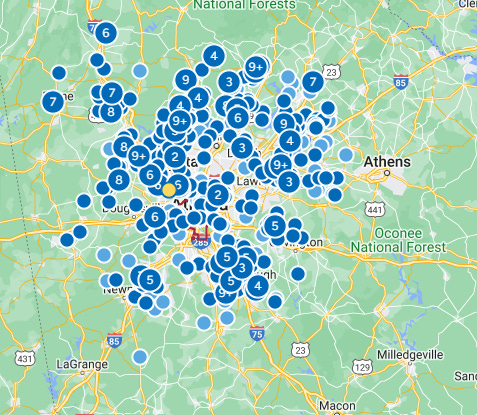One of the reasons I am such a fan of Walking Dead - and there are many reasons even though I can’t watch most scenes with my eyes open - resulted from the fact that the majority of its filming took place in familiar territory near Senoia, GA about 15 minutes from my father’s neck of the woods and 40 miles from downtown Atlanta. I have been traveling to Atlanta since the age of 12; even living there the summer of the 1996 Olympics where I worked as a hospitality guide for Carlson Travel, while also waiting tables at the Rose & Crown in Buckhead. My goal in Hotlanta that summer, where I spent endless hours with the windows rolled down (no AC), stuck on I-75, sun blazing, sweat pouring, was to make enough money to not have to work my first semester at NYU. I made a lot of money for young me, but still had to take a job pretty quickly after moving to New York as the financial aid and tiny scholarships received didn’t go very far in the city that (used-to) never sleep.
When Atlanta won the Olympics bid in September of 1990, it spurred dreams of a New, New South; a “renaissance” for the region that just could not escape its bad reputation, fueled by poverty stats and cultural bias. The vision for Atlanta was grand and would be inclusive of a light-rail expansion which never quite lived up to its promise. For perspective and a little bit of history, the first New South movement started after the Civil War as Reconstruction failed to wrangle the South:
During and immediately after the Civil War, many northerners headed to the southern states, driven by hopes of economic gain, a desire to work on behalf of the newly emancipated enslaved people or a combination of both. These “carpetbaggers”—whom many in the South viewed as opportunists looking to exploit and profit from the region’s misfortunes…would play a central role in shaping new southern governments during Reconstruction.
The “carpetbaggers” descended on the South hoping to profit from its resurrection, but as the scandals of that era necessitated a new ideology, the term “New South” was born, originating from speeches and articles written by Henry W. Grady, the editor of the Atlanta Constitution. Grady’s rhetoric focused on the promise of a growing economy where the sins of the past could be eschewed through integration for shared prosperity. The reality as captured by written histories of the time though is that the story of that period was not uplifting and ennobling, but rather
A story of the decay and decline of the aristocracy, the suffering and betrayal of the poor whites, and the rise and transformation of the middle class. It is not a happy story...The declining aristocracy are ineffectual and money hungry, and in the last analysis they subordinated the values of their political and social heritage in or to maintain control over the black population. The poor whites suffered from strange malignancies of racism and conspiracy-mindedness, and the middle class was timid and self-interested even in its reform movement. The most sympathetic characters in the whole sordid affair are simply those who are too powerless to be blamed for their actions.
Origins of the New South in Retrospect, Sheldon Hackney
So what is the New, New South? In many ways it is the idea, like the Old New South, that through industry (not farming), productivity and shared prosperity the wounds of the past can be healed. Think the democratic liberal (JFK Jr stand-in/Patrick Dempsey) in Sweet Home Alabama, filmed in Georgia, standing in the middle of a Civil War reenactment. After breaking up with the main character on that battlefield, seemingly rejecting her Southern culture, he capitulates, realizing he must come down off his Yankee horse and accept those less fortunate than him, mainly because it will play well politically and make his mother angry - bonus. Filmed in 2002, the plot line follows a Southerner who goes off to the big city to make it, but realizes she still loves her high-school boyfriend and that there is something worth holding onto in her roots. This realization however does not occur until after she finds out Jake is not such a redneck after all and is the creator of the Yankeefied, socially acceptable and importantly acceptable to her NY friends, Deep South Glass. The movie ends with Melanie and Jake’s nuptials and the idea that somehow these two worlds can co-exist.
Not to get Putin-like with my history of the South, but I think it is important to recognize that since the Civil War there have been many narratives around revitalizing the South, all of which have petered out as mania met the hard realities or facts on the ground. The history of the South is very complicated and politically rife, and there is no way to do it justice here. For an interesting take on that time period and its connection to our own, I recommend Turchin’s End Times: Elites, Counter-Elites, and the Path of Political Disintegration. Nonetheless, I have been reminded of Reconstruction and its themes as I have driven my way across the South in witness of yet another mania, another rebuild.
Founded in 1837, Atlanta, formerly nicknamed Terminus for its rail location, boasts the busiest airport by passenger traffic and according to the city’s official website has the third largest concentration of Fortune 500 companies.


*Atlanta map of inventory for sale: Zillow inventory on left and New Home Source new-build communities (not homes) on the right
So what did I see in Atlanta on this latest trip and how does it resemble Terminus? Let’s begin…
Keep reading with a 7-day free trial
Subscribe to M3_Melody Substack to keep reading this post and get 7 days of free access to the full post archives.




